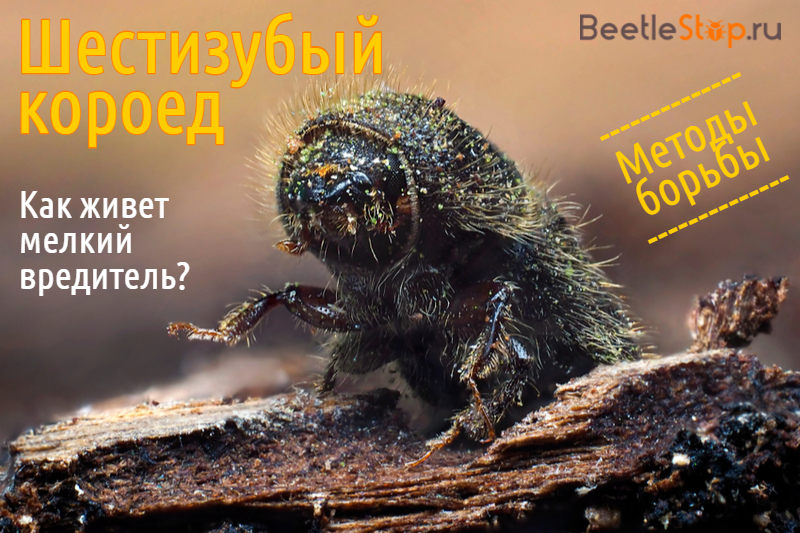Six-Tooth Bark Beetle - How to Protect Pines from a Pest
Bark beetles are a group of insects that feed on shoots and trunks. The subfamily has 750 species. The smallest species do not exceed 1 mm in length, tropical beetles grow up to 25 mm. Insects are dangerous pests of coniferous forests. Six-tooth bark beetle is found on pine, spruce, cedar, and fir. Inhabits weakened trunks and sawn trees. In hot summers, beetles give up to three generations. Timely deforestation and the use of hunting trees help keep pest numbers under control.

Morphological description of the species
Six-tooth bark beetle (Ips sexdentatus) beetle from the family of weevils, subfamily of bark beetle (Scolytinae). It refers to stem pests. This is one of the largest bark beetles in Russia, the body length is 6-8 mm. Only one species of Dendroctonus micans is slightly larger - 9 mm. The body of the beetle is elongated, the covers are shiny, weakly hairy. The color is brown or black, young insects are yellow. The hairs on the body are light, yellowish. The head is small, pulled into the prothorax. Antenna short, articulated, with a clearly defined mace. The eyes are round.
Information. The synonyms of the names of the six-toed bark beetle are: shorthand or large pine bark beetle.
The pronotum is almost equal in size to the elytra, covered with small dots. Elytra with longitudinal rows of points, smooth spaces between grooves. At the end is a deep indentation called a wheelbarrow. It is designed to push wood dust out of the moves. On each side of the cavity there are 6 teeth. This feature gave a species name. The fourth in a row is the largest with a flat outgrowth. Insects have hind wings adapted for flight. The coxae of the forelegs are almost round, the tibiae flat, covered with teeth. Paws are yellow-brown. All three pairs of limbs are covered with hairs.
Distribution area
Large pine bark beetle is distributed in the territory from Western Europe to Primorye. It is found in Russia in the Crimea, the Caucasus, Siberia and the Far East.
Lifestyle
Stenographers settle among rare plantations, in pine trees and spruce forests, damaged by insects, gnawing needles. They can be found among the burnt, in the windbreak, in the warehouses of unbroken lumber. Six-tooth bark beetles prefer warmed glades. Insects are active from spring to autumn, years begin in April-May. In the southern regions, the whole summer continues. In most of the habitat, annual generation. In hot at steady high temperatures for several months 2-3 generations of beetles are born.
Breeding
In spring, the male gnaws at a random chamber in the trunk, where it mates with several females. Fertilized females arrange uterine passages up to 40 cm long and 3-4 mm wide. These are the largest tunnels among European species. Females lay translucent eggs along the way. White larvae appear from them. The body is curved, legs are absent. There are numerous callous pads on the sides for movement. The head is brown-red with strong covers, the body is soft.
Information. Larvae feed on plant tissues, their movement leaves a curvy pattern under the bark.
At the end of the larval passages, cradles for pupae are arranged.Young individuals appear from mid to late June. Beetles make a hole for departure. Males prepare their own chambers for reproduction, females begin additional nutrition of wood. Adults winter in their own old passages.
Malware
Six-tooth bark beetle mainly harms pine - Crimean and ordinary. It attacks trees weakened by diseases or other pests. The stenographer's larvae damage the forehead, cambium, and the inside of the cortex.
Control measures
In some years, outbreaks of mass reproduction of a large pine bark beetle occur. Significant areas of coniferous forests are affected by beetles. The outbreak is limited by the state of the feed base. In forestry, beetles undergo detailed and reconnaissance surveillance. Upon examination, signs of the settlement of trees are recorded:
- inlets on trunks;
- drill flour;
- resin funnels.
Young trees planted next to pine forests are treated with chemicals Caesar, Talstar, and Balazo. Spraying is carried out in April. Sanitary cuttings are carried out systematically in forests. They are held in the winter or in the second half of June. The main method of fighting is laying out hunting trees. In early spring, in March-April, felled pines with branches are laid out on free sites. Debarking trees and pests are carried out until the end of June. This is the period when young beetles are located directly under the bark.

